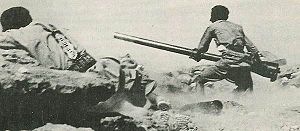| North Yemen civil war | |||||||
|---|---|---|---|---|---|---|---|
| Part of the Arab Cold War | |||||||
 Royalist Yemeni forces attempt to repel an Egyptian armored attack | |||||||
| |||||||
| Belligerents | |||||||
|
Supported by: |
Supported by: | ||||||
| Commanders and leaders | |||||||
|
|
| ||||||
| Strength | |||||||
|
1965: |
1964: 1967: | ||||||
| Casualties and losses | |||||||
|
|
| ||||||
| 100,000[12]–200,000 killed overall[13] | |||||||
| Part of the Politics series |
| Republicanism |
|---|
|
|
The North Yemen civil war, also known as the 26 September Revolution,[b] was a civil war fought in North Yemen from 1962 to 1970 between partisans of the Mutawakkilite Kingdom and supporters of the Yemen Arab Republic. The war began with a coup d'état carried out in 1962 by revolutionary republicans led by the army under the command of Abdullah as-Sallal. He dethroned the newly crowned King and Imam Muhammad al-Badr and declared Yemen a republic under his presidency. His government abolished slavery in Yemen.[14] The Imam escaped to the Saudi Arabian border where he rallied popular support from northern Zaydi tribes to retake power, and the conflict rapidly escalated to a full-scale civil war.
On the royalist side, Jordan, Saudi Arabia, and Israel[4] supplied military aid, and Britain offered covert support. The republicans were supported by Egypt (then formally known as the United Arab Republic or UAR) and were supplied warplanes from the Soviet Union.[2]
Both foreign irregular and conventional forces were also involved. Egyptian President Gamal Abdel Nasser supported the republicans with as many as 70,000 Egyptian troops and weapons. Despite several military actions and peace conferences, the war sank into a stalemate by the mid-1960s.
Egypt's commitment to the war is considered to have been detrimental to its performance in the June 1967 Six-Day War against Israel. Once the Six-Day War began, Nasser found it increasingly difficult to maintain his army's involvement in Yemen and began to pull out his forces. The surprising removal of Sallal on November 5 by Yemeni dissidents, who were supported by republican tribesmen, resulted in an internal shift of power in the capital, as the royalists were approaching from the north.
The new republican government was headed by Abdul Rahman Iryani, Ahmed Noman, and Mohamed Ali Uthman, all of whom promptly resigned or fled the country. The capital was left under the control of Prime Minister Hassan al-Amri. The 1967 siege of Sana'a became the turning point of the war. The remaining republican Prime Minister succeeded in keeping control of Sana'a and, by February 1968, the royalists lifted the siege.
Clashes continued in parallel with peace talks until 1970, when Saudi Arabia recognized the Republic,[15] and a ceasefire came into effect.[16]
Egyptian military historians refer to the war in Yemen as their "Vietnam [War]".[3] Historian Michael Oren (former Israeli Ambassador to the U.S.) later wrote that Egypt's military adventure in Yemen was so disastrous that the United States' actions in the continuing Vietnam War could easily have been dubbed "America's Yemen".[17]
- ^ a b c Michael Brecher and Jonathan Wilkenfel. A Study of Crisis: pp. 324–325. University of Michigan Press. 1997. "The four actors in the first phase of the long Yemen War were Jordan, Saudi Arabia, Egypt and Yemen"
- ^ a b c d e f Sandler, Stanley. Ground Warfare: The International Encyclopedia. Vol. 1 (2002): p. 977. "Egypt immediately began sending military supplies and troops to assist the Republicans... On the royalist side Jordan and Saudi Arabia were furnishing military aid, and Britain lent diplomatic support. In addition to Egyptian aid, the Soviet Union supplied 24 MiG-19s to the republicans."
- ^ a b c d e f g h i Aboul-Enein, Youssef (2004-01-01). "The Egyptian–Yemen War: Egyptian Perspectives on Guerrilla Warfare". Infantry Magazine. No. Jan–Feb, 2004. Archived from the original on 2016-09-21. Retrieved 5 August 2016.
- ^ a b Beit-Hallahmi, Benjamin (1987). The Israeli connection: who Israel arms and why (1st ed.). New York: Pantheon Books. p. 17. ISBN 978-0394559223. Retrieved 28 September 2019.
- ^ a b Pollack (2002), p. 54.
- ^ "Protected Blog › Log in". Archived from the original on 2016-05-29. Retrieved 2016-08-07.
- ^ Pollack (2002), p. 53
- ^ Pollack (2002), p. 55
- ^ "B&J": Jacob Bercovitch and Richard Jackson, International Conflict: A Chronological Encyclopedia of Conflicts and Their Management 1945–1995 (1997)
- ^ "Mid-Range Wars and Atrocities of the Twentieth Century". Erols. Archived from the original on August 9, 2013. Retrieved August 29, 2008.
- ^ Pollack (2002), p. 56
- ^ Singer, Joel David, The Wages of War. 1816–1965 (1972)
- ^ "Archived copy" (PDF). Archived from the original (PDF) on 2012-03-20. Retrieved 2012-10-15.
{{cite web}}: CS1 maint: archived copy as title (link) "Since 1965, the Libyan-backed Front for the Liberation of Occupied South Yemen and the National Liberation Front had unleashed brutal violence on British forces in the south. In the end, the conflict claimed some 200,000 lives." - ^ Miers, S. (2003). Slavery in the Twentieth Century: The Evolution of a Global Problem. Storbritannien: AltaMira Press. p. 352 [ISBN missing]
- ^ "Yemen: History". TDS. Archived from the original on September 6, 2008. Retrieved August 29, 2008.
- ^ "Yemen". MSN Encarta. Archived from the original on 2009-10-28. Retrieved August 29, 2008.
- ^ Oren (2002), p. 7
Cite error: There are <ref group=lower-alpha> tags or {{efn}} templates on this page, but the references will not show without a {{reflist|group=lower-alpha}} template or {{notelist}} template (see the help page).